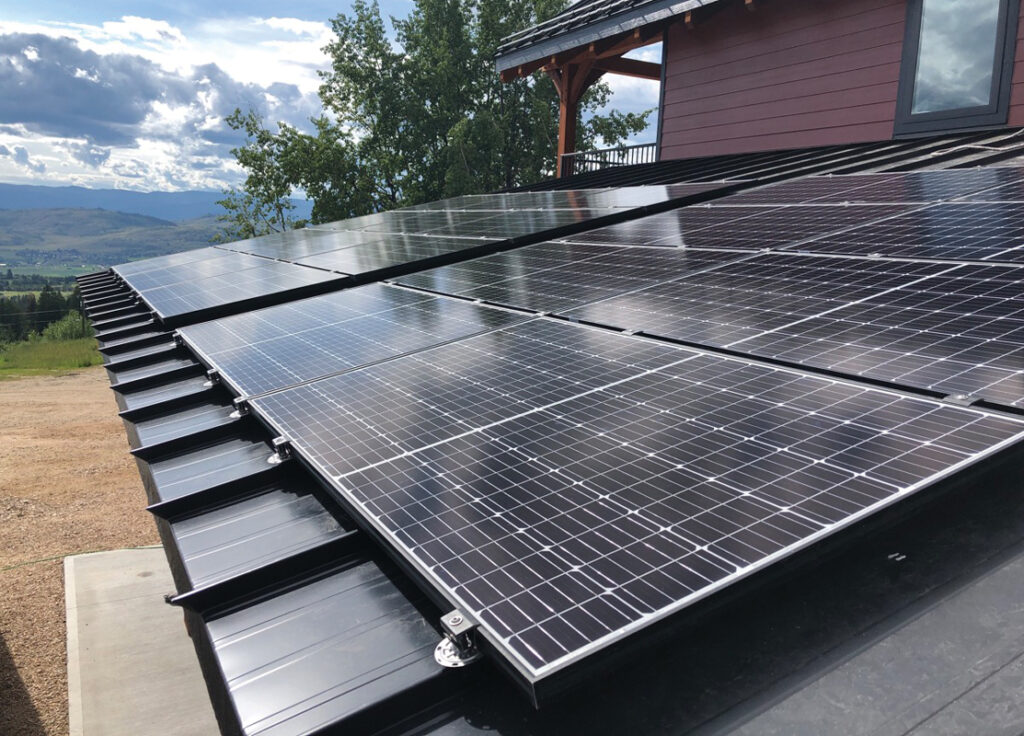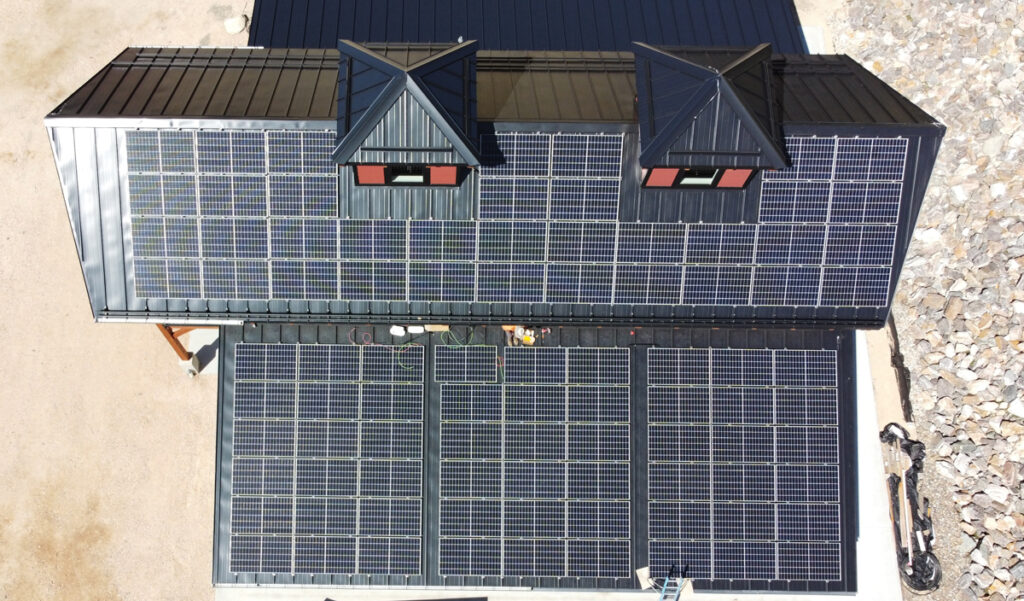By Build My Barndo Staff
Solar panel systems have been used on homes for decades, and recently they have experienced a surge in popularity as many strive to live more sustainably. They still account for just a small fraction of the overall residential housing market. According to Statista.com, as of 2023, only 4.4 million, or close to 5% of single-family homes have solar panel systems. They forecast that number to almost quadruple by the year 2032.
Is This a Good Time to Get Into Solar Energy?
With generous federal and state financial tax and rebate incentives for homeowners, combined with sharply decreasing costs for solar panels and the potential for savings on your power bill, this may be the perfect time for you to add solar to your new barndo.
The federal initiative to replace gas-powered vehicles with electric means that it only makes sense to set up garages and carports with solar panels to charge electric vehicles. Home is by far the most convenient place to charge an electric vehicle and that the free electricity eventually offsets the initial expense of installing a solar system. After that, charging at home is completely free. Free fuel is a powerful incentive for building a garage or carport with a solar panel system.
The Basics of Solar Panel Systems
Since solar panel systems are currently used in only a small part of the residential market, many builders may have little or no direct experience with solar systems. The builder is not likely installing the system, but you need to work with your builder at the very beginning stages to create a plan to accommodate solar power, as it affects so many aspects of the construction planning, including building location and orientation. A south facing roof angled at 30 to 45 degrees and that’s not shaded by buildings, trees, or other obstructions is best.
If the general contractor and/or builder don’t do the solar work themselves, they will need to work with a licensed solar panel company to do the planning and installation of the system. The design needs specialized knowledge. For instance, the calculation to determine the optimum panel setup for a structure can be complex because so many variables are involved. There are many solar system companies to choose from. Do careful research to find a reliable company with good reviews and warranties.
Homeowners should also consult their insurance company, as solar panels can raise insurance rates. Although wind and hail coverage for panels might be included in a standard insurance policy, a solar panel system may raise the value of the home and increase the rates for that reason.
Once an on-grid solar system is installed, it will need an inspection and Permission to Operate (PTO) from the utility company. If the building and solar systems are done by separate companies, the General Contractor or builder’s role is to meet the building’s structural requirements, ensuring that the proper permits, codes, and zoning for the structure are done completely and correctly. The solar panel installation company is responsible for the permits and codes for installing the solar system and the electrical work.
Before talking to anyone about a solar system, there are several online tools, such as a Peak Sun Hours map and a Solar Calculator, to help determine what the ramifications of a solar panel system would be for your particular situation. A Peak Sun Hours map will show the average hours of sun per month for each state. A Solar Calculator will help you do the math on system size needed, cost, tax incentives and rebates, potential monthly savings, and estimated number of years to reach the payback point.
A peak sun hours map shows the average peak hours of sun for each state. In the continental United States, that varies between 3.5 and 6 hours. A solar calculator can help a builder and homeowner do the math on the system size needed, its estimated cost, tax incentives and rebates, potential monthly savings, and estimated number of years to reach the payback point.


Solar System Photos Courtesy of S-5!
Monthly Peak Sun Hours Maps
• solarreviews.com/blog/how-many-solar-panels-do-i-need-to-run-my-house
• https://unboundsolar.com/solar-information/sun-hours-us-map
Solar Calculators
• solarreviews.com/solar-calculator
• https://unboundsolar.com/solar-information/solar-cost
Planning a Solar Panel System
After reviewing these planning tools, the selected solar panel system company will evaluate your proposed new structure’s pertinent characteristics, such as its geographic location, average light per day, roof size, position on the property, obstructions that could block sunlight, direction and angle of the roof, roofing material and age, and power requirements to determine if the proposed system will deliver the results needed and, if so, the number of solar panels needed and whether the roof is strong enough to support the solar panels system and handle wind uplift and snow loads. A reputable solar installer will use proper attachments to connect the solar panels to the roof.
Solar Glossary
Inverter: A device that converts DC power to AC power
String: The group of panels connected to a single inverter
Array: All the solar strings connected to form a solar system
PV: Photovoltaic (PV) panels that comprise a solar panel system
Solar Panel System Types
On-Grid (Tied In)
An on-grid solar panel system ties into an existing power grid through a utility company, typically using a net metering system, which is a two-way connection to the power grid that measures how much is drawn from the grid when the solar panel is not producing electricity, as well as the amount of excess electricity the solar panel system contributes to the power grid. With the net metering system, the utility applies a credit to the solar panel owner for electricity produced above what is drawn from the grid, so you should enjoy great savings on your energy bill.
The amount of your savings, however, depends largely on your utility company. Some companies charge for their power at high retail rates but credit the excess power from solar panels at a much lower wholesale rate. Sometimes you will be credited more favorably, and sometimes the rates vary depending on the time of day and the corresponding level of power demand on the grid. Evaluate the utility company’s terms carefully before committing to a long-term plan based heavily on the ability to sell power back to the utility.
Off-Grid
An off-grid system is not connected to the existing power grid. That means it’s totally dependent on solar panels for electricity. It won’t be able to draw any power from a power line when the solar panels can’t keep up with demand. For that reason, a battery storage system is essential to store power for times when the panels aren’t producing power, which would be the majority of a 24-hour period.
If you are considering going off the grid, you should know that some lifestyle adjustments may be necessary. For example, you may need to research for the highest efficiency appliances available and get in the habit of unplugging items that aren’t in use, and in general you may have to watch your energy consumption.
Off-grid systems are often used for limited power requirements such as garage or shed, especially if it is either inaccessible to a power line or is so far from a house that the cost of digging a trench and running wire from it is cost prohibitive.
When an off-grid system is chosen, an inverter is needed to convert the DC charge generated by the solar panels into AC used by household electrical receptacles. The system also needs a solar charge controller to regulate the current and voltage supplied by the solar panels to allow safe and efficient battery charging.
An off-grid system works great for smaller structures and lower power needs such as running an overhead light and or charging an electric lawn mower, trimmer, and/or other devices in a shed or garage. Some small ones are available in a DIY kit, which doesn’t need a permit or inspection since they’re low power and not tied into the grid. Small off-grid solar vents can also be added to sheds, garages, attics, greenhouses, and other small structures to control heat, improve air circulation, and lower humidity..
Hybrid
A hybrid solar panel system is both tied into the power grid and has a backup battery system. While a battery backup system is very expensive, it does offer a couple of advantages. First, it provides backup power during a power outage on the grid. Second, it can allow homeowners to store power during times of the day when power rates are low and to meter them back to the grid during high-demand/high-rate hours so the owner can be credited with the higher rates. However, with this strategy, the payback period for batteries can be quite long — 20 to 30 years, according to some sources. So, the biggest benefit of a hybrid system isn’t making money by selling power back to the utility but having backup power during a power outage.
Charging Electric Vehicles with Solar Panels
While it’s most common to have an EV charging system that’s tied into the grid, an off-grid solar panel system can completely recharge an electric vehicle if it’s connected to an adequate number of panels exclusively dedicated to it. The typical number of dedicated panels varies from 7 to 12 depending on the type of vehicle, driving habits, area of country, etc. An off-grid system would also typically have a battery storage system to store electricity when the panels aren’t producing power. For more information, visit energysage.com/ev-charging/how-many-panels-do-you-need-for-your-ev.
The Federal Solar Tax Credit (ITC)
From 2024 to 2032, the federal solar tax credit, known as the Investment Tax Credit or ITC, is 30% for qualified solar electric costs, including solar panels, other components such as wiring and inverters, mounting equipment, batteries, labor, and sales tax. To qualify for the tax credit, the solar installer must be licensed, and the applicant must own the system (not lease it), and it must be on-grid. Some solar system companies will only install residential installations that are on-grid. The federal solar tax credit will decrease to 26% in 2033, to 22% in 2034, and will be eliminated completely in 2035 unless renewed by Congress. For more details, visit marketwatch.com/guides/solar/federal-solar-tax-credits.
Other Solar Incentives
In addition to the federal solar tax credit, other incentives are available, such as rebates, subsidies, low-interest loans, and state tax credits. These vary according to area and timeframe. Find more information from the following sources:
• https://unboundsolar.com/solar-information/state-solar-incentives
• forbes.com/home-improvement/solar/solar-tax-credit-by-state
solarreviews.com/blog/the-top-solar-incentive-programs-in-the-us• solarreviews.com/blog/the-top-solar-incentive-programs-in-the-us






















